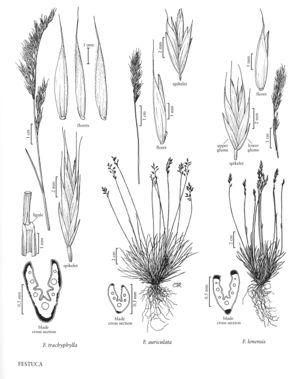Festuca auriculata
Plants densely cespitose, without rhizomes. Culms 8-25(40) cm, erect, smooth, glabrous or pubescent below the inflorescence. Sheaths closed for about 1/2 their length, smooth or scabrous, glabrous or puberulent, persistent; collars glabrous; ligules 0.1-0.5 mm; blades 0.4-0.8(1) mm in diameter, conduplicate, abaxial surfaces glabrous, pubescent, or pilose, all conditions often present on the same plant, scabrous at the apices, adaxial surfaces scabrous or pubescent on the ribs, veins 5-7, ribs 3-5, 1 distinct and 2-4 indistinct; abaxial sclerenchyma in 3 strands, 2 marginal and 1 opposite the midvein, rarely with 2 additional strands, the strands narrower than the veins and usually less than twice as wide as high; adaxial sclerenchyma strands absent; flag leaf blades 0.5-2 cm. Inflorescences 2-3.5 cm, racemes or panicles, contracted, with 1(2) branches per node; branches erect, lower branches usually with 1-2 spikelets. Spikelets 5-6.5(8) mm, with 3-5(6) florets. Glumes exceeded by the upper florets, ovate to lanceolate, glabrous, sometimes scabrous distally; lower glumes about 3 mm; upper glumes about 4 mm; lemmas 4-5 mm, ovate to ovate-lanceolate, glabrous, sometimes scabrous towards the apices, apices acute, awns 0.8-2(2.5) mm, terminal; paleas about as long as the lemmas, intercostal region smooth or scabrous distally; anthers 2-3.5 mm; ovary apices glabrous. 2n = 14.
Distribution
Alaska, Yukon
Discussion
Festuca auriculata is an amphiberingian species that extends from the Ural Mountains of Russia through Alaska to the western continental Northwest Territories. It grows on dry, rocky cliffs and slopes, in low arctic and alpine regions. In the Flora region, this species seems to intergrade with, and is sometimes included in, F. lenensis (see next). The two species tend to differ in their leaf surfaces as well as in the width of their sclerenchyma strands. Festuca auriculata has also frequently been included in F. ovina (p. 422).
Selected References
None.
